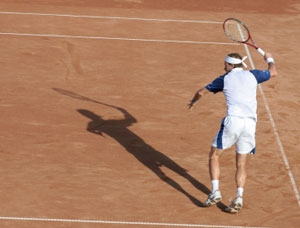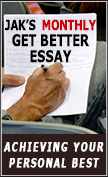OCTOBER, 2011:
THE EASY BALLS ARE NOT EASY
How many times have you heard your peers mumbling something like this after a perceived bad miss: "C'mon, how can you miss a ball right to you?" How many times have you thought the same thing?
 Yet these "easy balls" are from it. They negate the advantages of "bodies in motion stay in motion." Instead they enable the opposite "bodies at rest stay at rest." Make no mistake about it, this is no easy conundrum. But it’s not unusual at all for players to misperceive the difficulty inherent in handling these kinds of balls, particularly in doubles where you’re only covering a small part of the back court and the balls are right in your zone.
Yet these "easy balls" are from it. They negate the advantages of "bodies in motion stay in motion." Instead they enable the opposite "bodies at rest stay at rest." Make no mistake about it, this is no easy conundrum. But it’s not unusual at all for players to misperceive the difficulty inherent in handling these kinds of balls, particularly in doubles where you’re only covering a small part of the back court and the balls are right in your zone.
Balls that require lateral or forward movement trigger the bodies in motion response. The natural athleticism triggered in hitting-on-the-run recall one's motor skill memory and fully support ball striking timing. It just flows.
Incoming balls right at you, body shots, disable this process and lead to static positioning, i.e. just standing there and waiting. That would be analogous to turning your car’s engine off at a red traffic light, resulting in a disconnection from the task at hand versus keeping the motor idling until the light turns green even though you’re stationary. On the tennis court that’s a recipe for repeated "how could I miss that ball" unforced errors.
If that's not enough, factor in that it's much more difficult to read the bounce angle on a ball that's right in front of you than it is if it's off to one side.
Stutter steps become the only viable solution. Think Jimmy Connors, the best proponent of this good footwork component ever. Not the fastest player of his era, but the best at staying in motion when balls were approaching right at him. Although not going anywhere, Jimmy would take 3,4,5,6,7 little steps before launching his shot. Eye-foot coordination supporting eye-hand coordination. That’s how it works! Why do you think he goes down as one of the very best returners of all-time? Footwork.
So forget about the "get-set" cue I still hear being bandied about far too often. Do not get planted. Do not stand there doing nothing, waiting for the ball which, in the absence of physicality, always leads to over conscious negative thinking and its accompanying glazed-over poor ball tracking. Instead "set-up," utilizing those stutter steps, to create the same no-brainer athleticism that occurs so naturally when you're on the run.
Good stutter-stepping footwork seemingly doesn't matter - until it does.
Questions and comments are welcome at anytime for all tips present and past via email.
This Tip of the Month is copyright© by Jak Beardsworth Tennis. All rights reserved. Copies may be made only with the permission of and by Jak Beardsworth. Contact him here.
Tips Archive
- May, June, 2013 JUST TALKING HEADS OR MORE [read more]
- March, April, 2013 SELF-TALK: Good, Bad, or Indifferent [read more]
- January, February, 2013 BOOK-A-MILLION: Do Tennis Players Read? [read more]
- December, 2012 THE KEY TO TOUR LEVEL BALL STRIKING: And How to Learn It [read more]
- November, 2012 ARE YOU A THUDDER, A TWANGER, OR A PINGER: Racket Dampeners [read more]
- September, October, 2012 SMART SHOTS [read more]
- July, August, 2012 TEN TOP STRESS REDUCERS [read more]
- June, 2012 MAKING YOUR LESSONS STICK [read more]
- May, 2012 THE IMPOSSIBLE: Accelerating and Decelerating Simultaneously [read more]
- April, 2012 PLAYER DISCONNECTION [read more]
- March, 2012 BENDING THE SERVE IN [read more]
- February, 2012 UNDERSTANDING TERMINOLOGY: Drill vs Clinic vs Team Practice [read more]
- January, 2012 PLAYING SCARED? [read more]
- December, 2011 CUTTING OFF THE ANGLE…VERTICALLY [read more]
- November, 2011 WHY COACHING? [read more]
- October, 2011 THE EASY BALLS ARE NOT EASY [read more]
- August/September, 2011 NEVER TOO LATE FOR OLDER DOGS [read more]
- June/July, 2011 HARD COURTS, SOFT COURTS, and YOUR BODY'S ADAPTATION [read more]
- April/May, 2011 JAW DROPPNG [read more]
- March, 2011 CLUB DOUBLES' INCREASINGLY MISSING LINK [read more]
- February, 2011 TIP 2 | POOH POOHING DOUBLES STRATEGY SESSIONS [read more]
- February, 2011 TIP 1 | CLAY TO HARD, HARD TO CLAY [read more]
- January, 2011 ICING THE SERVER WHEN RECEIVING IN THE BIG MOMENTS [read more]
- December, 2010 JOHN ISNER’S “GOOD MISS” [read more]
- November, 2010 THE MOST NEGLECTED SHOT IN THE GAME [read more]
- October, 2010 BALL BOUNCING and the SERVE [read more]
- September, 2010 TAKE YOUR EYE OFF THE BALL [read more]
- July-August, 2010 SUMMER SCHOOL COURTSIDE CRIB SHEET [read more]
- May-June, 2010 THE 2-HANDED JUMP BACKHAND: The Dumbest Shot in Tennis [read more]
- April, 2010 THE STANDING AROUND SYNDROME [read more]
- March, 2010 THE ELUSIVE SERVICE TOSS [read more]
- February, 2010 PREPARING TO START THE POINT: Serving and Receiving [read more]
- January, 2010 DEBUNKING THE MODERN GAME [read more]
- December, 2009 RELAX – IT'S JUST A RALLY BALL [read more]
- November, 2009 DEFEATING THE POACHER [read more]
- October, 2009 PRACTICE, PRACTICE, PRACTICE [read more]
- September, 2009 SERVING SUCCESS: Warming-Up vs Match Play [read more]
- August, 2009 THE SPLIT STEP: Defending the Court, Rushing the Net, and More [read more]
- July, 2009 THE THIRD GROUNDSTROKE [read more]
- June, 2009 HOW MANY HANDS DOES IT TAKE? [read more]
- May, 2009 THE MOST IMPORTANT SKILL [read more]
- April, 2009 PLAYING IN THE FLORIDA WIND [read more]
- March, 2009 Letting them Play for Peak Performance in Clubland [read more]
- February, 2009 SUPPORTING YOUR GAME [read more]
- January, 2009 RESPECTING THE GAME: Top 10 Do's & Don'ts [read more]
- December, 2008 Getting the Warm-up Right [read more]
- November, 2008 Visualize...Realize: The Mind Body Connection [read more]
- October, 2008 Reading Their Mail [read more]


